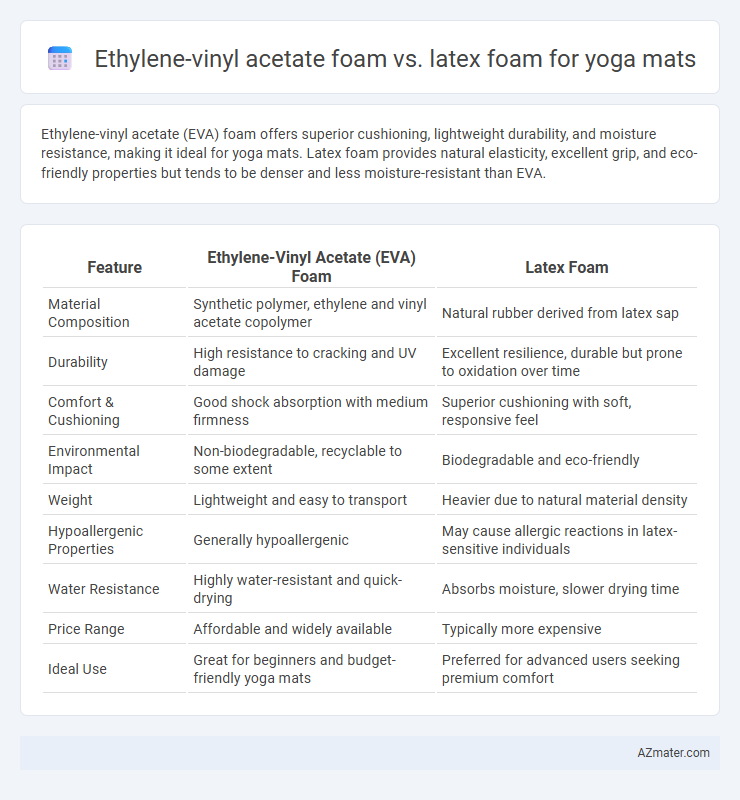Ethylene-vinyl acetate (EVA) foam offers superior cushioning, lightweight durability, and moisture resistance, making it ideal for yoga mats. Latex foam provides natural elasticity, excellent grip, and eco-friendly properties but tends to be denser and less moisture-resistant than EVA.
Table of Comparison
| Feature | Ethylene-Vinyl Acetate (EVA) Foam | Latex Foam |
|---|---|---|
| Material Composition | Synthetic polymer, ethylene and vinyl acetate copolymer | Natural rubber derived from latex sap |
| Durability | High resistance to cracking and UV damage | Excellent resilience, durable but prone to oxidation over time |
| Comfort & Cushioning | Good shock absorption with medium firmness | Superior cushioning with soft, responsive feel |
| Environmental Impact | Non-biodegradable, recyclable to some extent | Biodegradable and eco-friendly |
| Weight | Lightweight and easy to transport | Heavier due to natural material density |
| Hypoallergenic Properties | Generally hypoallergenic | May cause allergic reactions in latex-sensitive individuals |
| Water Resistance | Highly water-resistant and quick-drying | Absorbs moisture, slower drying time |
| Price Range | Affordable and widely available | Typically more expensive |
| Ideal Use | Great for beginners and budget-friendly yoga mats | Preferred for advanced users seeking premium comfort |
Introduction to Yoga Mat Materials
Ethylene-vinyl acetate (EVA) foam and latex foam are two popular materials used for yoga mats, each offering distinct benefits. EVA foam is lightweight, durable, and resistant to moisture, making it ideal for beginner-friendly mats with good cushioning and support. Latex foam provides superior elasticity and natural antimicrobial properties, appealing to eco-conscious practitioners seeking a more natural and non-toxic surface.
What is Ethylene-Vinyl Acetate (EVA) Foam?
Ethylene-Vinyl Acetate (EVA) foam is a highly flexible, durable, and lightweight polymer used extensively in yoga mats for its excellent cushioning and shock absorption properties. EVA foam offers superior resistance to cracking and UV radiation, maintaining its integrity and comfort over prolonged use. Compared to latex foam, EVA is hypoallergenic and moisture-resistant, making it an ideal choice for users seeking a low-maintenance, long-lasting yoga mat material.
Overview of Latex Foam for Yoga Mats
Latex foam for yoga mats offers excellent durability, high resilience, and natural antibacterial properties, making it an eco-friendly choice for practitioners. Its superior cushioning and moisture resistance provide enhanced comfort and support during various yoga poses, promoting joint protection and stability. Compared to Ethylene-vinyl acetate foam, latex foam tends to be more sustainable, biodegradable, and resistant to odor build-up, aligning with the preferences of health-conscious and environmentally aware users.
Durability: EVA vs Latex Foam
Ethylene-vinyl acetate (EVA) foam offers superior durability compared to latex foam, making it more resistant to cracking, tearing, and compression over time. EVA foam maintains its resilience and cushioning properties even after prolonged use, whereas latex foam may degrade faster due to natural material breakdown and exposure to moisture. This durability difference makes EVA foam a preferred choice for long-lasting yoga mats under frequent use conditions.
Cushioning and Comfort Comparison
Ethylene-vinyl acetate (EVA) foam offers excellent cushioning with a lightweight and flexible structure, making it a popular choice for yoga mats that require shock absorption and durability. Latex foam provides superior comfort due to its natural elasticity and responsiveness, ensuring better support and pressure relief during prolonged practice. While EVA foam excels in impact protection, latex foam is often preferred for its enhanced softness and breathable properties, contributing to a more comfortable yoga experience.
Grip and Traction Differences
Ethylene-vinyl acetate (EVA) foam yoga mats offer superior grip due to their closed-cell structure, providing excellent traction on both dry and slightly sweaty surfaces, which reduces slippage during intense poses. Latex foam mats feature a naturally tacky texture that enhances grip, especially in sweaty conditions, and their open-cell structure allows better moisture absorption but requires more maintenance to maintain traction. While EVA foam excels in durability and water resistance for steady grip, latex foam delivers enhanced tactile feedback and traction for practitioners seeking a more responsive surface.
Eco-friendliness and Sustainability
Ethylene-vinyl acetate (EVA) foam is widely used for yoga mats due to its durability and cushioning but is derived from non-renewable petroleum sources, raising concerns about environmental impact and biodegradability. Latex foam, sourced from natural rubber trees, offers superior eco-friendliness by being biodegradable and renewable, significantly reducing carbon footprint and waste compared to synthetic alternatives. When prioritizing sustainability, natural latex mats are preferred for their compostable properties and minimal chemical processing, aligning with environmentally conscious yoga practices.
Allergen Concerns: EVA vs Latex
Ethylene-vinyl acetate (EVA) foam is hypoallergenic and free from natural proteins, making it an ideal choice for individuals with latex allergies or sensitive skin. Latex foam contains natural rubber proteins, which can trigger allergic reactions in susceptible users, including skin irritation and respiratory issues. Choosing EVA foam reduces allergen concerns while providing similar cushioning and durability for yoga mats.
Cost and Value Analysis
Ethylene-vinyl acetate (EVA) foam typically offers a lower production cost compared to latex foam, making it a budget-friendly option for yoga mats without compromising durability and cushioning. Latex foam, though more expensive due to natural material sourcing and processing, provides superior elasticity, resilience, and eco-friendliness, delivering long-term value through enhanced comfort and sustainability. When analyzing cost versus value, EVA foam suits cost-conscious buyers seeking adequate performance, while latex foam appeals to practitioners prioritizing premium quality and environmental benefits.
Choosing the Best Foam for Your Yoga Practice
Ethylene-vinyl acetate (EVA) foam offers superior shock absorption, lightweight durability, and moisture resistance, making it ideal for high-impact or sweaty yoga sessions. Latex foam provides excellent natural elasticity, breathability, and eco-friendliness, preferred by practitioners seeking sustainable and odour-free mats. Selecting the best foam depends on whether you prioritize cushioning and durability (EVA) or comfort and environmental benefits (latex).

Infographic: Ethylene-vinyl acetate foam vs Latex foam for Yoga mat
 azmater.com
azmater.com